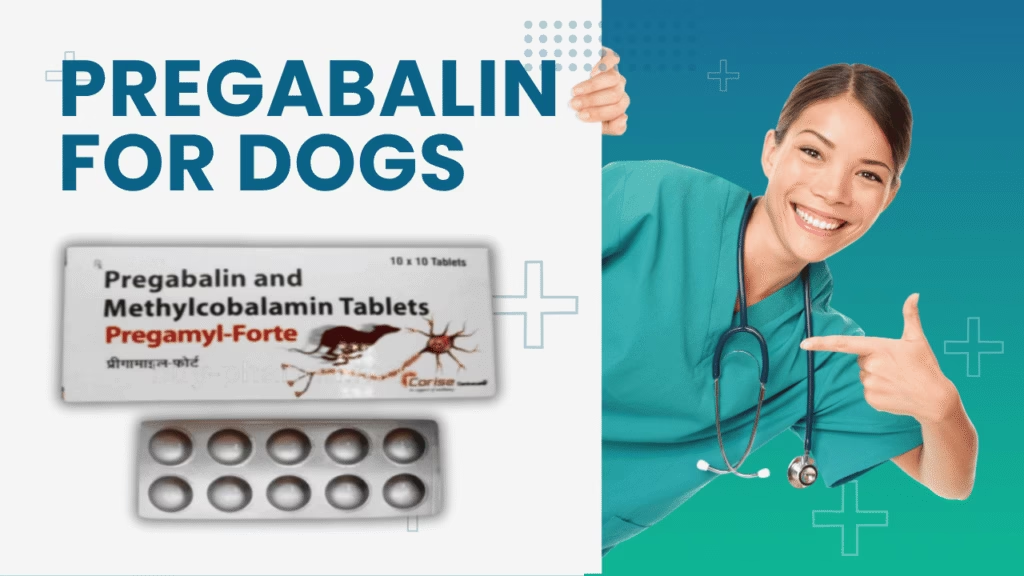What is Pregabalin for Dogs? Benefits and Uses
Watching a dog suffer from nerve pain or seizures is never easy. That’s where pregabalin, an anticonvulsant and pain-relieving medication, comes in. Often prescribed by veterinarians, it helps manage seizures and provides relief from nerve or cancer-related pain. I’ve seen how this medication works wonders, offering quick relief and improving comfort for both dogs and cats. By calming the nervous system, pregabalin helps manage convulsions and chronic pain, making it a crucial treatment for pets facing these challenges.
How do I give my pet pregabalin?
Pregabalin is a medication commonly prescribed for dogs to manage issues like nerve pain and seizures. Available in both capsule and liquid suspension forms, this short-acting drug works fast, usually taking effect within 1 to 2 hours. It can be given orally to your pet, either with food or on an empty stomach.
For more on how to manage your pet’s health, check out Doxycycline Dosage Chart for Dogs.

One thing to keep in mind is that pregabalin should be administered for the entire duration as prescribed by your veterinarian, even if your pet starts feeling better. Stopping it suddenly is not recommended. While the effects typically wear off after 24 hours, they may be prolonged in pets dealing with kidney or liver issues.
- Capsule, liquid, suspension
- Orally, mouth, food, empty stomach
- Medication, pet, better, prescribed
- Take effect quickly, 1 to 2 hours, short-acting
- Stop, 24 hours, prolonged, kidney, liver, disease
Potential Side Effects of Pregabalin in Dogs: What to Watch Out For.
Pregabalin may cause several side effects in dogs, which can include decreased energy, tiredness, or sleepiness. Some dogs might experience loss of coordination or weakness. Though less common, there are rare reactions that can happen, and these should be treated as emergencies. If your dog shows signs of an allergic reaction, like irregular breathing, rash, fever, or swelling around the face, it’s important to contact your veterinarian immediately.
Over time, drug sensitivities may develop, even if your dog has not had any reactions to the medication initially. It’s crucial to monitor your dog closely during the entire course of treatment to catch any issues early.
- Decreased energy, tiredness, sleepiness
- Loss of coordination, weakness
- Allergic reactions: Irregular breathing, rash, fever, swelling around the face
- Contact a veterinarian if severe reactions occur
- Drug sensitivities may develop with repeated exposure
- Monitor closely throughout treatment
Additionally, for other related medications, you can learn more about Sulfasalazine for Dogs: A Game-Changer for Pain Relief.
Pregabalin for Dogs: Risk Factors and Safety Precautions
Pregabalin treats seizures and nerve pain in dogs, but should be avoided in pregnant, nursing, or breeding pets. It can cause side effects like decreased energy or tiredness, and in rare cases, more serious reactions like swelling or rash. Always follow the veterinarian’s prescribed dose and monitor for drug sensitivities.
Pregabalin and Drug Interactions: What Dog Owners Need to Know
Before starting pregabalin for your dog, always tell your veterinarian about any other medications, vitamins, supplements, or herbal therapies your pet is taking. These could interact with the new treatment. It’s crucial to ensure your dog’s health is fully managed, as I’ve learned firsthand how important it is to check all the details before starting any new medication.Learn more about other medications like Clavamox Dosage for Dogs.
Monitoring Your Dog During Pregabalin Treatment: Key Considerations
- If your veterinarian prescribes two different medications for your dog, a drug interaction may be anticipated, which could affect how each medication works.
- In this case, the veterinarian may adjust the dose of one or both medications or monitor your pet more closely to ensure they are reacting well to the treatments.
- It’s important to attend any follow-up visits that your veterinarian schedules for monitoring your dog’s progress, as these visits allow the vet to check for side effects or effectiveness.
- Always follow your veterinarian’s directions exactly to ensure that the treatment is as safe and effective as possible for your pet.
- For more on managing other treatments, check out Naproxen for Dogs: Pros, Cons, and Safe Alternatives.
How to Properly Store Pregabalin for Dogs: Best Practices
- Store your dog’s medication at room temperature to maintain its effectiveness.
- Keep the capsules away from moisture to prevent any damage to the medication.
- Always keep the medication out of the reach of children and other pets to avoid accidental ingestion.
Also, for proper dosage management, you can check out the Minocycline for Dogs Dosage Guide.
Potential Side-Effects of Pregabalin
Pregabalin, like phenobarbital, reduces Glutamate neurotransmitter activity in the brain, which can affect other neurons and lead to lethargy and other side effects. When my dog started on pregabalin, we closely monitored him for reactions such as:
- Dry mouth, dizziness, constipation
- Nausea, vomiting, gas
- Weight gain, sores, and redness on his skin
It’s important to monitor pets closely, especially when they experience these side effects.
How should this medication be given?
When using pregabalin for your dog, it’s important to give the medication exactly as prescribed by your veterinarian. Always double-check the prescription label to make sure you are giving the drug correctly. Pregabalin can be administered with or without food, but if your pet becomes sick or vomits after taking it on an empty stomach, try giving it with a small treat or food to see if it helps.

If the vomiting continues, it’s crucial to contact your veterinarian. If you decide to stop the medication before the prescription is complete, always contact your vet first. There might be an important reason to continue the treatment until it’s finished. When using pregabalin for seizures, never stop the medication suddenly, as this can cause more seizures to occur.
How Long Before Pregabalin Starts Working and How Long It Lasts
When your dog is given pregabalin, you should see them feel better within 1 to 2 hours. During this time, clinical signs like pain or discomfort should begin to improve. The effects of pregabalin are short-lived, so they will generally stop working after about 24 hours. I’ve personally found this timeframe helpful when monitoring my dog’s response to the medication. It’s essential to stick to the prescribed schedule, as the medication needs to be given at regular intervals for the best results. Keep in mind that this medication is effective in the short term and requires continuous monitoring.
What to Do if You Miss a Dose of Pregabalin
- If you miss a dose, wait and give the next dose when it’s usually time to do so.
- Do not double-up doses or provide an extra dose.
- Consistency is important, but if you’re unsure, always contact your veterinarian.
What Happens If You Overdose Your Dog on Pregabalin
If you suspect that your dog may have been given an overdose of pregabalin, it’s important to seek emergency veterinary attention immediately. Overdoses can worsen side effects like sleepiness, loss of coordination, and diarrhea, which could become dangerous. I’ve had a situation where I worried about an overdose, and it was reassuring to know that I could contact my veterinarian or even an animal poison control center for expert advice. Always act quickly and don’t hesitate to reach out for professional guidance.
Precautions for Using Pregabalin in Dogs
When your dog is on pregabalin, it’s important to monitor for possible interactions if they’re also taking medications like ACE inhibitors, antidepressants, antihistamines, or anti-anxiety medications. These combinations can affect how the medications work, requiring careful supervision by a veterinarian. Always inform your vet about any current medications.
Special Considerations for Pregabalin Treatment
Pregabalin should be avoided in pregnant or nursing pets due to potential risks. I’ve learned that it’s important to ensure the safety of the pet’s condition before administering the medication. Sensitivity to the drug can also be a concern, so check with your vet before starting treatment.
To learn more about how other medications can impact your dog, read about Simplicef 100mg for Dogs Guide.
Monitoring Your Dog During Pregabalin Treatment
Close monitoring is crucial when using pregabalin for seizure control in dogs. It’s important to observe for any side effects like dizziness or lethargy that could arise. I noticed these effects in my dog and had to adjust the dosage under my vet’s advice.
Adjusting the Dosage of Pregabalin for Your Dog
If your pet is on multiple medications, the dose of pregabalin may need to be adjusted. This ensures that the combination of treatments does not lead to negative reactions. Always follow your veterinarian’s advice on how to manage pregabalin alongside other medications to avoid complications.
Popular Pregabalin Dosage Forms for Dogs
When it comes to giving pregabalin to your dog, accurate dosing is crucial, especially for pets that are hard to medicate. I’ve found that Wedgewood’s medication options are a lifesaver, as they provide dosing forms and strengths that ensure the right amount is administered. This was especially helpful when my dog needed pregabalin for seizure control, making the process much smoother. Having the right medication and accurate dosing is key to managing your pet’s condition effectively and safely.
DOSAGE FORM BENEFITS STRENGTHS
Anhydrous Oral Suspension Glycerin-based oral solution with a wide variety of flavoring options, 16 mg/ml to 60 mg/ml
Capsule Oral medication available in gelatin or veggie capsule options, 1.5 mg/cap to 125 mg/cap
Chew Treat Flavored, medicated oral soft chew treats 5 mg/chew to 100 mg/chew.
What to Do in Case of Emergency with Pregabalin
If you ever suspect an overdose or notice an adverse reaction to pregabalin, it’s crucial to call your veterinary office immediately. In case your vet isn’t available, follow their directions to contact an emergency facility. I’ve had to do this myself when I noticed unusual symptoms in my dog after giving the pet medication. Acting fast and reaching out for professional help is essential to ensure your pet’s safety, so never hesitate to get the necessary assistance.



Pingback: Pregabalin for Dogs :7 Powerful Benefits You Shouldn’t Ignore – petdepth.com
fnyomjorppidrmvhlvzmyhqfzwymtw
The use of Pregabalin for dogs seems to be gaining popularity among veterinarians and pet owners. It appears to be effective in managing chronic pain, seizures, and anxiety in dogs, even though it’s not FDA-approved for animals. The drug works by calming overactive nerve signals, which can significantly improve a dog’s quality of life. It’s particularly helpful for dogs with nerve damage, cancer, or severe anxiety. How does Pregabalin compare to other medications like gabapentin or tramadol in terms of safety and effectiveness? German news in Russian (новости Германии)— quirky, bold, and hypnotically captivating. Like a telegram from a parallel Europe. Care to take a peek?
Thank you for your lovely comment.